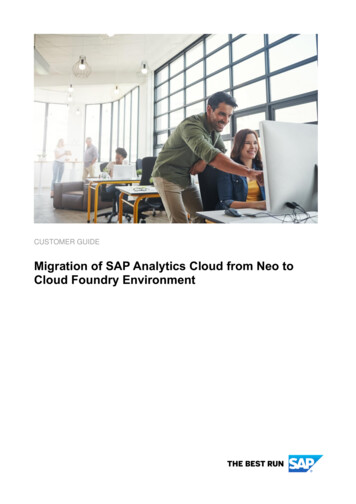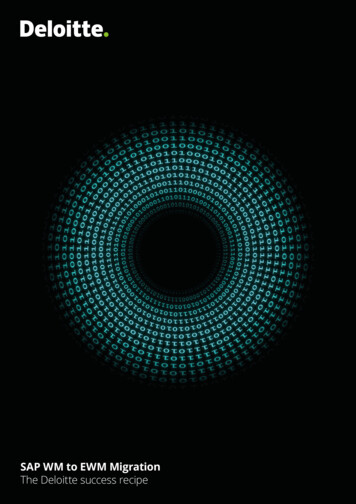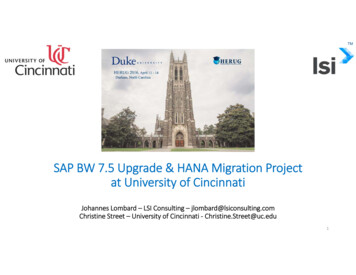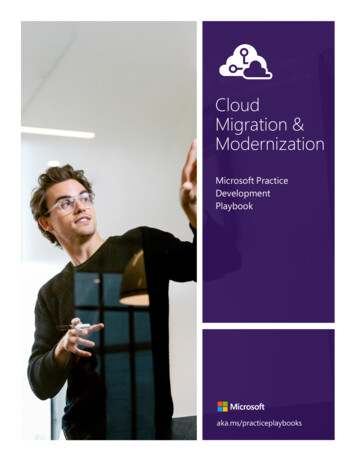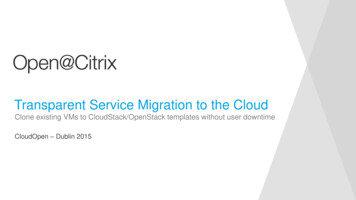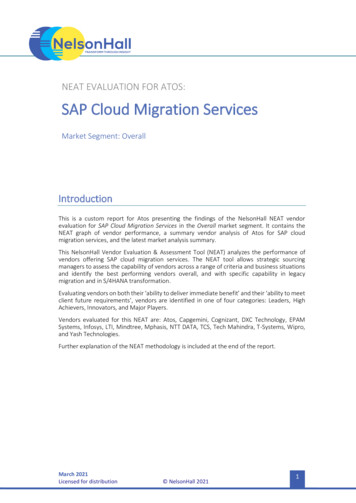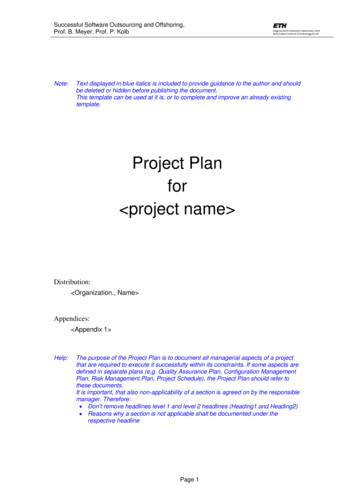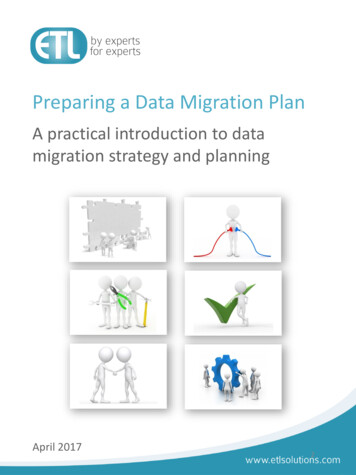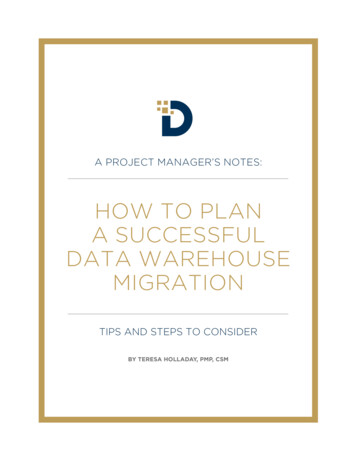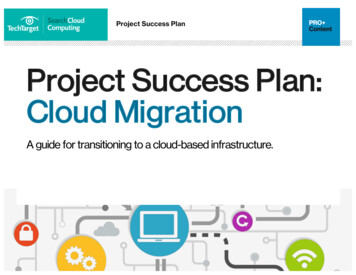
Transcription
Project Success PlanProject Success Plan:Cloud MigrationA guide for transitioning to a cloud-based infrastructure.
Project Success Plan: Cloud MigrationIn this guideWhat is Cloud ComputingKey terms to understandWhy consider a cloudmigration project?Why not migrate to the cloud?Top considerations forchoosing a cloud providerPrivate cloud hardwareplanningBudgetingStaffing SkillsPublic vs. Private vs. HybridPlanning for migrationCalculating ROIExpert tips and adviceGetting more PRO essentialcontentPage 1 of 87In this e-guide:Due to rapid advancement in cloud technology and the wellpublicized benefits of utilizing cloud services, IT pros havebecome the voice of reason, objectively weighing the pros –flexibility, scalability, cost-savings – against the cons – securityrisks, management challenges. Determining when/wherecloud is appropriate, and where it can have the most benefit inyour organization, by critically assessing your infrastructure isthe only means of devising a sound migration strategy.So, what cloud tools are available? What obstacles will you runinto? Where do you begin? This comprehensive guide walksreaders through the entire process of a migration to cloudinfrastructure, from the initial phases of a cloud planningthrough to the monitoring and management of a fullytransitioned cloud environment.
Project Success Plan: Cloud MigrationIn this guideWhat is Cloud ComputingKey terms to understandWhy consider a cloudmigration project?Why not migrate to the cloud?Top considerations forchoosing a cloud providerPrivate cloud hardwareplanningBudgetingWhat is Cloud m/definition/cloud-computingCloud computing is a general term for the delivery of hosted services overthe Internet.Cloud computing enables companies to consume compute resources as autility -- just like electricity -- rather than having to build and maintaincomputing infrastructures in-house.Cloud computing promises several attractive benefits for businesses andend users. Three of the main benefits of cloud computing include: Self-service provisioning: End users can spin up computing resourcesfor almost any type of workload on-demand. Elasticity: Companies can scale up as computing needs increase andthen scale down again as demands decrease. Pay per use: Computing resources are measured at a granular level,allowing users to pay only for the resources and workloads they use.Staffing SkillsPublic vs. Private vs. HybridPlanning for migrationCalculating ROIExpert tips and adviceGetting more PRO essentialcontentPage 2 of 87Cloud computing services can be private, public or hybrid.
Project Success Plan: Cloud MigrationIn this guideWhat is Cloud ComputingPrivate cloud services are delivered from a business' data center to internalusers. This model offers versatility and convenience, while preservingmanagement, control and security. Internal customers may or may not bebilled for services through IT chargeback.Key terms to understandWhy consider a cloudmigration project?Why not migrate to the cloud?Top considerations forchoosing a cloud providerPrivate cloud hardwareplanningBudgetingStaffing SkillsPublic vs. Private vs. HybridPlanning for migrationCalculating ROIExpert tips and adviceGetting more PRO essentialcontentPage 3 of 87In the public cloud model, a third-party provider delivers the cloud serviceover the Internet. Public cloud services are sold on-demand, typically by theminute or the hour. Customers only pay for the CPU cycles, storage orbandwidth they consume. Leading public cloud providers include AmazonWeb Services (AWS), Microsoft Azure, IBM/SoftLayer and Google ComputeEngine.Hybrid cloud is a combination of public cloud services and on-premisesprivate cloud – with orchestration and automation between the two.Companies can run mission-critical workloads or sensitive applications onthe private cloud while using the public cloud for bursty workloads that mustscale on-demand. The goal of hybrid cloud is to create a unified, automated,scalable environment which takes advantage of all that a public cloudinfrastructure can provide, while still maintaining control over mission-criticaldata.Although cloud computing has changed over time, it has always beendivided into three broad service categories: infrastructure as a service(IaaS), platform as a service (PaaS) and software as service (SaaS).
Project Success Plan: Cloud MigrationIn this guideWhat is Cloud ComputingKey terms to understandWhy consider a cloudmigration project?Why not migrate to the cloud?Top considerations forchoosing a cloud providerPrivate cloud hardwareplanningBudgetingStaffing SkillsPublic vs. Private vs. HybridPlanning for migrationIaaS providers such as AWS supply a virtual server instance and storage, aswell as application program interfaces (APIs) that let users migrateworkloads to a virtual machine (VM). Users have an allocated storagecapacity and start, stop, access and configure the VM and storage asdesired. IaaS providers offer small, medium, large, extra-large, and memoryor compute-optimized instances, in addition to customized instances, forvarious workload needs.In the PaaS model, providers host development tools on theirinfrastructures. Users access those tools over the Internet using APIs, Webportals or gateway software. PaaS is used for general softwaredevelopment and many PaaS providers will host the software after it'sdeveloped. Common PaaS providers include Salesforce.com's Force.com,Amazon Elastic Beanstalk and Google App Engine.SaaS is a distribution model that delivers software applications over theInternet; these are often called Web services. Microsoft Office 365 is a SaaSoffering for productivity software and email services. Users can accessSaaS applications and services from any location using a computer ormobile device that has Internet access. .Calculating ROIExpert tips and adviceGetting more PRO essentialcontentPage 4 of 87Next article
Project Success Plan: Cloud MigrationIn this guideWhat is Cloud ComputingKey terms to understandWhy consider a cloudmigration project?Key terms to understandInfrastructure as a Service ucture as a Service (IaaS) is a form of cloud computing that providesvirtualized computing resources over the Internet. IaaS is one of three maincategories of cloud computing services, alongside Software as a Service(SaaS) and Platform as a Service (PaaS).Why not migrate to the cloud?Top considerations forchoosing a cloud providerPrivate cloud hardwareplanningBudgetingStaffing SkillsPublic vs. Private vs. HybridPlanning for migrationIn an IaaS model, a third-party provider hosts hardware, software, servers,storage and other infrastructure components on behalf of its users. IaaSproviders also host users' applications and handle tasks including systemmaintenance, backup and resiliency planning.IaaS platforms offer highly scalable resources that can be adjusted ondemand. This makes IaaS well-suited for workloads that are temporary,experimental or change unexpectedly.Other characteristics of IaaS environments include the automation ofadministrative tasks, dynamic scaling, desktop virtualization and policybased services.Calculating ROIExpert tips and adviceGetting more PRO essentialcontentPage 5 of 87IaaS customers pay on a per-use basis, typically by the hour, week or month.Some providers also charge customers based on the amount of virtualmachine space they use. This pay-as-you-go model eliminates the capital
Project Success Plan: Cloud MigrationIn this guideWhat is Cloud ComputingKey terms to understandWhy consider a cloudmigration project?Why not migrate to the cloud?Top considerations forchoosing a cloud providerPrivate cloud hardwareplanningBudgetingStaffing Skillsexpense of deploying in-house hardware and software. However, usersshould monitor their IaaS environments closely to avoid being charged forunauthorized services.Because IaaS providers own the infrastructure, systems management andmonitoring may become more difficult for users. Also, if an IaaS providerexperiences downtime, users' workloads may be affected.For example, if a business is developing a new software product, it might bemore cost-effective to host and test the application through an IaaSprovider. Once the new software is tested and refined, it can be removedfrom the IaaS environment for a more traditional in-house deployment or tosave money or free the resources for other projects.Leading IaaS providers include Amazon Web Services (AWS), WindowsAzure, Google Compute Engine, Rackspace Open Cloud, and IBMSmartCloud Enterprise.Public vs. Private vs. HybridPlatform as a Service (PaaS)Planning for migrationCalculating ROIExpert tips and adviceGetting more PRO essentialcontentPage 6 of ition/Platform-as-a-Service-PaaSPlatform as a service (PaaS) is a cloud computing model that deliversapplications over the Internet. In a PaaS model, a cloud provider delivershardware and software tools -- usually those needed for applicationdevelopment -- to its users as a service. A PaaS provider hosts the hardware
Project Success Plan: Cloud MigrationIn this guideWhat is Cloud ComputingKey terms to understandWhy consider a cloudmigration project?Why not migrate to the cloud?Top considerations forchoosing a cloud providerPrivate cloud hardwareplanningBudgetingStaffing SkillsPublic vs. Private vs. HybridPlanning for migrationand software on its own infrastructure. As a result, PaaS frees users fromhaving to install in-house hardware and software to develop or run a newapplication.PaaS does not typically replace a business' entire infrastructure. Instead, abusiness relies on PaaS providers for key services, such as Javadevelopment or application hosting. For example, deploying a typicalbusiness tool locally might require an IT team to buy and install hardware,operating systems, middleware (such as databases, Web servers and so on)the actual application, define user access or security, and then add theapplication to existing systems management or application performancemonitoring (APM) tools. IT teams must then maintain all of these resourcesover time. A PaaS provider, however, supports all the underlying computingand software; users only need to log in and start using the platform – usuallythrough a Web browser interface.Most PaaS platforms are geared toward software development, and theyoffer developers several advantages. For example, PaaS allows developersto frequently change or upgrade operating system features. It also helpsdevelopment teams collaborate on projects.Calculating ROIExpert tips and adviceGetting more PRO essentialcontentPage 7 of 87Users typically access PaaS through a Web browser. PaaS providers thencharge for that access on a per-use basis. Some PaaS providers charge aflat monthly fee to access the platform and the apps hosted within it. It is
Project Success Plan: Cloud MigrationIn this guideWhat is Cloud ComputingKey terms to understandWhy consider a cloudmigration project?Why not migrate to the cloud?Top considerations forchoosing a cloud providerPrivate cloud hardwareplanningBudgetingStaffing SkillsPublic vs. Private vs. HybridPlanning for migrationCalculating ROIExpert tips and adviceGetting more PRO essentialcontentPage 8 of 87important to discuss pricing, service uptime and support with a PaaSprovider before engaging their services.Since users rely on a provider's infrastructure and software, vendor lock-incan be an issue in PaaS environments. Other risks associated with PaaS areprovider downtime or a provider changing its development roadmap. If aprovider stops supporting a certain programming language, users may beforced to change their programming language, or the provider itself. Bothare difficult and disruptive steps.Common PaaS vendors include Salesforce.com's Force.com, which providesan enterprise customer relationship management (CRM) platform. PaaSplatforms for software development and management include Appear IQ,Mendix, Amazon Web Services (AWS) Elastic Beanstalk, Google App Engineand Heroku.PaaS is one of three main categories of cloud computing services. The othertwo are software as a service (SaaS) and infrastructure as a service (IaaS).Software as a Service efinition/Software-as-a-ServiceSoftware as a Service (SaaS) is a software distribution model in whichapplications are hosted by a vendor or service provider and made availableto customers over a network, typically the Internet.
Project Success Plan: Cloud MigrationIn this guideWhat is Cloud ComputingKey terms to understandWhy consider a cloudmigration project?Why not migrate to the cloud?Top considerations forchoosing a cloud providerPrivate cloud hardwareplanningBudgetingSaaS is becoming an increasingly prevalent delivery model as underlyingtechnologies that support Web services and service-oriented architecture(SOA) mature and new developmental approaches, such as Ajax, becomepopular. Meanwhile, broadband service has become increasingly available tosupport user access from more areas around the world.SaaS is closely related to the ASP (application service provider) and ondemand computing software delivery models. IDC identifies two slightlydifferent delivery models for SaaS. The hosted application management(hosted AM) model is similar to ASP: a provider hosts commercially availablesoftware for customers and delivers it over the Web. In the software ondemand model, the provider gives customers network-based access to asingle copy of an application created specifically for SaaS distribution.Benefits of the SaaS model include:Staffing Skills easier administrationPublic vs. Private vs. Hybrid automatic updates and patch managementPlanning for migration compatibility: All users will have the same version of software.Calculating ROI easier collaboration, for the same reasonExpert tips and advice global accessibilityGetting more PRO essentialcontentPage 9 of 87
Project Success Plan: Cloud MigrationIn this guideWhat is Cloud ComputingKey terms to understandWhy consider a cloudmigration project?Why not migrate to the cloud?Top considerations forchoosing a cloud providerPrivate cloud hardwareplanningBudgetingStaffing SkillsPublic vs. Private vs. HybridPlanning for migrationCalculating ROIExpert tips and adviceGetting more PRO essentialcontentPage 10 of 87The traditional model of software distribution, in which software ispurchased for and installed on personal computers, is sometimes referred toas software as a product.Private cloud (internal cloud or corporate efinition/private-cloudPrivate cloud is a type of cloud computing that delivers similar advantages topublic cloud, including scalability and self-service, but through a proprietaryarchitecture. Unlike public clouds, which deliver services to multipleorganizations, a private cloud is dedicated to a single organization.As a result, private cloud is best for businesses with dynamic orunpredictable computing needs that require direct control over theirenvironments.Public and private cloud deployment models differ. Public clouds, such asthose from Amazon Web Services or Google Compute Engine, share acomputing infrastructure across different users, business units orbusinesses. However, these shared computing environments aren't suitablefor all businesses, such as those with mission-critical workloads, securityconcerns, uptime requirements or management demands. Instead, thesebusinesses can provision a portion of their existing data center as an onpremises -- or private -- cloud.
Project Success Plan: Cloud MigrationIn this guideWhat is Cloud ComputingKey terms to understandWhy consider a cloudmigration project?Why not migrate to the cloud?A private cloud provides the same basic benefits of public cloud. Theseinclude self-service and scalability; multi-tenancy; the ability to provisionmachines; changing computing resources on-demand; and creating multiplemachines for complex computing jobs, such as big data. Chargeback toolstrack computing usage, and business units pay only for the resources theyuse.Public finition/public-cloudPrivate cloud hardwareplanningA public cloud is one based on the standard cloud computing model, inwhich a service provider makes resources, such as applications and storage,available to the general public over the Internet. Public cloud services maybe free or offered on a pay-per-usage model.BudgetingThe main benefits of using a public cloud service are:Top considerations forchoosing a cloud providerStaffing Skills Easy and inexpensive set-up because hardware, application andbandwidth costs are covered by the provider.Planning for migration Scalability to meet needs.Calculating ROI No wasted resources because you pay for what you use.Public vs. Private vs. HybridExpert tips and adviceGetting more PRO essentialcontentPage 11 of 87The term "public cloud" arose to differentiate between the standard modeland the private cloud, which is a proprietary network or data center that
Project Success Plan: Cloud MigrationIn this guideWhat is Cloud ComputingKey terms to understandWhy consider a cloudmigration project?Why not migrate to the cloud?Top considerations forchoosing a cloud providerPrivate cloud hardwareplanningBudgetingStaffing SkillsPublic vs. Private vs. HybridPlanning for migrationCalculating ROIExpert tips and adviceGetting more PRO essentialcontentPage 12 of 87uses cloud computing technologies, such as virtualization. A private cloud ismanaged by the organization it serves. A third model, the hybrid cloud, ismaintained by both internal and external providers.Examples of public clouds include Amazon Elastic Compute Cloud (EC2),IBM's Blue Cloud, Sun Cloud, Google AppEngine and Windows AzureServices Platform.Hybrid finition/hybrid-cloudHybrid cloud is a cloud computing environment which uses a mix of onpremises, private cloud and public cloud services with orchestrationbetween the two platforms. By allowing workloads to move between privateand public clouds as computing needs and costs change, hybrid cloud givesbusinesses greater flexibility and more data deployment options.For example, an enterprise can deploy an on-premises private cloud to hostsensitive or critical workloads, but use a third-party public cloud provider,such as Google Compute Engine, to host less-critical resources, such astest and development workloads. To hold customer-facing archival andbackup data, a hybrid cloud could also use Amazon Simple Storage Service(Amazon S3). A software layer, such as Eucalyptus, can facilitate privatecloud connections to public clouds, such as Amazon Web Services (AWS).
Project Success Plan: Cloud MigrationIn this guideWhat is Cloud ComputingKey terms to understandWhy consider a cloudmigration project?Why not migrate to the cloud?Top considerations forchoosing a cloud providerPrivate cloud hardwareplanningBudgetingStaffing SkillsPublic vs. Private vs. HybridPlanning for migrationCalculating ROIExpert tips and adviceGetting more PRO essentialcontentPage 13 of 87Hybrid cloud is particularly valuable for dynamic or highly changeableworkloads. For example, a transactional order entry system thatexperiences significant demand spikes around the holiday season is a goodhybrid cloud candidate. The application could run in private cloud, but usecloud bursting to access additional computing resources from a public cloudwhen computing demands spike. To connect private and public cloudresources, this model requires a hybrid cloud environment.Another hybrid cloud use case is big data processing. A company, forexample, could use hybrid cloud storage to retain its accumulated business,sales, test and other data, and then run analytical queries in the public cloud,which can scale to support demanding distributed computing tasks.Public cloud's flexibility and scalability eliminates the need for a company tomake massive capital expenditures to accommodate short-term spikes indemand. The public cloud provider supplies compute resources, and thecompany only pays for the resources it consumes.Despite its benefits, hybrid cloud can present technical, business andmanagement challenges. Private cloud workloads must access and interactwith public cloud providers, so hybrid cloud requires API compatibility andsolid network connectivity.
Project Success Plan: Cloud MigrationIn this guideWhat is Cloud ComputingKey terms to understandWhy consider a cloudmigration project?Why not migrate to the cloud?Top considerations forchoosing a cloud providerFor the public cloud piece of hybrid cloud, there are potential connectivityissues, SLA breaches and other possible public cloud service disruptions. Tomitigate these risks, organizations can architect hybrid workloads thatinteroperate with multiple public cloud providers. However, this cancomplicate workload design and testing. In some cases, workloads slatedfor hybrid cloud must be redesigned to address the specific providers' APIs.Management tools such as Egenera PAN Cloud Director, RightScale CloudManagement and Scalr Enterprise Cloud Management Platform helpbusinesses handle workflow creation, service catalogs, billing and othertasks related to hybrid cloud.Private cloud hardwareplanningService-level agreement (SLA)BudgetingA service-level agreement (SLA) is a contract between a service providerand its internal or external customers that documents what services theprovider will furnish.Staffing SkillsPublic vs. Private vs. HybridPlanning for migrationCalculating ROIExpert tips and adviceGetting more PRO essentialcontentPage 14 of /service-level-agreementSLAs originated with network service providers, but are now widely used bytelecommunication service providers and cloud computing service providers.Corporate IT organizations, particularly those that have embraced IT servicemanagement (ITSM), enter SLAs with their in-house customers (users inother departments within the enterprise). An IT department creates an SLA
Project Success Plan: Cloud MigrationIn this guideWhat is Cloud ComputingKey terms to understandso that its services can be measured, justified and perhaps compared withthose of outsourcing vendors.SLAs measure the service provider’s performance and quality in a number ofways. Some metrics that SLAs may specify include: Availability and uptime -- the percentage of the time services will beavailable The number of concurrent users that can be served Specific performance benchmarks to which actual performance will beperiodically compared Application response time The schedule for notification in advance of network changes that mayaffect usersPublic vs. Private vs. Hybrid Help desk response time for various classes of problemsPlanning for migration Usage statistics that will be provided.Why consider a cloudmigration project?Why not migrate to the cloud?Top considerations forchoosing a cloud providerPrivate cloud hardwareplanningBudgetingStaffing SkillsCalculating ROIExpert tips and adviceGetting more PRO essentialcontentPage 15 of 87In addition to establishing performance metrics, an SLA may include a planfor addressing downtime and documentation for how the service providerwill compensate customers in the event of a contract breach. SLAs, onceestablished, should be periodically reviewed and updated to reflect changes
Project Success Plan: Cloud MigrationIn this guideWhat is Cloud ComputingKey terms to understandWhy consider a cloudmigration project?Why not migrate to the cloud?Top considerations forchoosing a cloud providerPrivate cloud hardwareplanningBudgetingStaffing SkillsPublic vs. Private vs. HybridPlanning for migrationCalculating ROIExpert tips and adviceGetting more PRO essentialcontentPage 16 of 87in technology and the impact of any new regulatory directives (changes tothe PCI DSS standard, for instance).
Project Success Plan: Cloud MigrationIn this guideWhat is Cloud ComputingKey terms to understandWhy consider a cloudmigration project?Why not migrate to the cloud?Top considerations forchoosing a cloud providerPrivate cloud hardwareplanningBudgetingStaffing SkillsPublic vs. Private vs. HybridPlanning for migrationWhy Consider a Cloud Migration migration-strategyOver the past decade, cloud services have rapidly become one of the mostdefining technologies in IT. The hype surrounding cloud services may makeit seem like all of an organization's resources should be migrated to thecloud immediately. There is no denying that, in certain cases, cloud servicescan be tremendously beneficial. In others, however, a cloud migrationprobably doesn't make sense.Organizations need to take a hard look at their existing investments ininfrastructure -- from hardware to application portfolios to networkarchitecture and beyond -- to determine if a move will be beneficial. Some ofthe migration questions are technical, such as whether a given applicationcan perform adequately in the cloud; some questions will involvenontechnical, budgetary issues, such as whether a cloud migration is costeffective given current investments in infrastructure.Calculating ROIExpert tips and adviceGetting more PRO essentialcontentPage 17 of 87Here we explore factors that should guide a cloud migration strategy andhelp determine whether to move on-premises workloads to the cloud.
Project Success Plan: Cloud MigrationIn this guideWhat is Cloud ComputingKey terms to understandWhy consider a cloudmigration project?Why not migrate to the cloud?Top considerations forchoosing a cloud providerPrivate cloud hardwareplanningBudgetingStaffing SkillsPublic vs. Private vs. HybridPlanning for migrationCalculating ROIExpert tips and adviceGetting more PRO essentialcontentPage 18 of 87One of the first considerations is an organization's existing data centerinvestment. Despite technologies such as server virtualization, there are realcosts associated with deploying on-premises servers. There are not onlylicensing costs involved, but also costs associated with hardware resourceconsumption and support infrastructure. As such, there is almost always asignificant investment associated with an on-premises server. Outsourcing aserver's data and/or functionality to the cloud may mean abandoning youron-premises investment unless an on-premises server can be repurposed.Although this rip-and-replace approach to cloud migrations may not makefinancial sense for organizations that have a large investment in an onpremises data center, an organization can still benefit from migrating certainon-premises resources to the cloud.No matter how good it is, any server hardware eventually becomes obsolete.Enterprise-class organizations have traditionally coped with this expectedobsolescence by adopting a hardware lifecycle policy. An organization, forexample, might choose to retire servers after five years. That being said, anorganization could integrate a cloud services roadmap into its hardwarelifecycle policy. Doing so allows IT teams to migrate on-premises resourcesto the cloud instead of moving them to newer hardware.
Project Success Plan: Cloud MigrationIn this guideWhat is Cloud ComputingKey terms to understandWhy consider a cloudmigration project?Why not migrate to the cloud?Top considerations forchoosing a cloud providerPrivate cloud hardwareplanningBudgetingStaffing SkillsPublic vs. Private vs. HybridPlanning for migrationThe prospect of using cloud services is often particularly attractive forsmaller organizations and startups. In the case of a smaller organization, theuse of cloud services provides access to enterprise-class hardware andfault-tolerant features that would otherwise be unaffordable. Similarly,startups can benefit from cloud services because they can get theiroperations running quickly without having to invest in on-premises datacenter resources.Application requirements for a cloud migrationIn the case of application servers, administrators must consider whether theapplication can function in the cloud. Likewise, the application's performancemust be considered.Compatibility usually isn't a big problem for newer applications that run ontop of modern operating systems. It is also easy to assume thatperformance won't be an issue for such applications because most cloudproviders will allow hardware resources to be allocated to hosted servers onan as-needed basis. However, two major considerations must be taken intoaccount for such applications.Calculating ROIExpert tips and adviceGetting more PRO essentialcontentPage 19 of 87The first is performance. Even though you can provision the hostedapplication server with nearly unlimited compute and memory resources,Internet bandwidth may impede application performance. It does little good
Project Success Plan: Cloud MigrationIn this guideWhat is Cloud ComputingKey terms to understandWhy consider a cloudmigration project?Why not migrate to the cloud?Top considerations forchoosing a cloud providerPrivate cloud hardwareplanningBudgetingStaffing SkillsPublic vs. Private vs. HybridPlanning for migrationCalculating ROIExpert tips and adviceGetting more PRO essentialcontentPage 20 of 87to have a high-performance hosted application server if Internet bandwidthlimitations stand in the way of a good user experience.The second consideration is application portability. Although it is often easyto migrate a virtualized application server to the cloud, the application mighthave external dependencies that rule out (or greatly complicate) a cloudmigration. For example, the application mig
Cloud computing is a general term for the delivery of hosted services over the Internet. Cloud computing enables companies to consume compute resources as a utility -- just like electricity -- rather than having to build and maintain computing infrastructures in-house. Cloud computing promis
